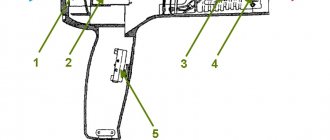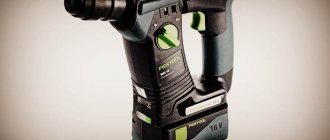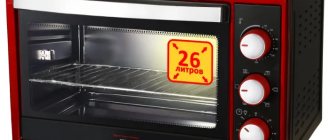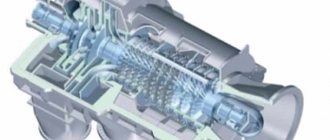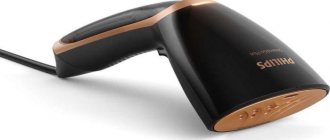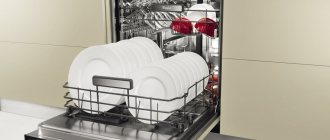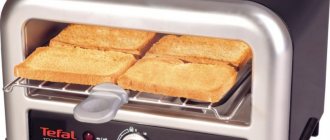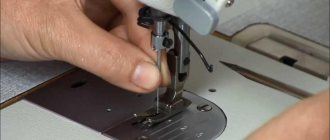Engine location
The horizontal layout is used, while in light hammer drills it is vertical. medium not heavy. However, there are no exceptions. Heavy hammer drill
Metabo KHE ninety-six, weighing almost twelve kg, has a horizontal engine.
A tool with a horizontal layout is more compact and not convenient for working in narrow spaces. However, this design is characterized by an increased shock load on the engine and somewhat worse cooling conditions.
The vertical layout provides better engine operating conditions (reduced shock vibration and effective cooling), in addition, a wider range of motion of the piston without the striker due to the ability to use it instead of an oscillating bearing
crank mechanism with increased piston stroke.
Rotary hammers with a vertical engine can withstand more intense work than models with a horizontal layout.
Cordless household hammer drill - an outlandish miracle of technology
This market segment is just being explored by manufacturers. The pioneer in this area is Bosch, but competitors such as Ryobi, Hitachi and Matrix are not asleep. Powerful cordless hammer drills, with an impact force of 3-10 J, are very rare. They are 3-8 times more expensive than their network counterparts. But low-power ones are represented by a wider range. The weight of such devices is almost 2 kg. Bosch supplies its product with a 14.4 or 18-volt battery. The Matrix is only sold with an 18-volt battery. But Ryobi and Hitachi generally ship without batteries and charging.
Impact mechanism
There are two main versions of the shock electro-pneumatic mechanism. using a swinging (drunk) bearing, in other words, a crank mechanism. Instructions and video
on the topic of how to properly disassemble
hammer drill
repair. The first option is used for light and, in part, medium hammer drills, the second. for medium not heavy.
The figure below shows a diagram of a light-type rotary hammer. Its impact mechanism consists of an oscillating bearing
, piston, ram is not striker.
During operation of the hammer drill, rotation from the electric motor is transmitted to the inner sleeve of the swing bearing . At the same time, its outer sleeve, together with a perpendicular axis connected to the piston, performs oscillatory movements. Between the piston and the ram there is an air space, which, thanks to the increased pressure and rarefaction created here alternately, forces the ram to repeat the oscillatory movements of the piston, striking the striker. The latter again hits the tool located in the chuck. Thus, the energy of the electric motor is transformed into the impact energy of the tool.
The pneumatic impact mechanism is equipped with a self-shutoff function when idling. Office, when the tool (drill, drill, bit) is not pressed to the surface being processed, the ram moves forward, opening a hole in the body for air to enter and exit. And therefore, this compression and vacuum are not created in the working air cavity, it is turned off, and the hammer drill
works without shocks. When the tool is pressed on the surface being processed, the hole is blocked by the ram, compression occurs in the air cavity, and the non-impact mechanism begins to function.
Electrical circuit and tool body
Lever removal diagram.
There are a large number of ways to adjust the rotation speed of the electric power unit of the tool. You can adjust the rotation speed by changing the force of pressing the start button. In addition, the rotation speed on some device models is set before use by rotating the control knob.
The electrical circuits of different models of rotary hammers may have significant differences from each other. The simplest electrical circuit of a rotary hammer resembles that of an electric drill.
The housing for mounting the mechanism is made of metal. As a rule, aluminum or magnesium alloys are used for its manufacture. For lightweight types of instruments, the housings are made of impact-resistant plastic. Sometimes you can find models in which both metal and impact-resistant plastic are used in the manufacture of the case. Metal is much stronger than plastic and promotes more efficient heat dissipation, which ensures faster cooling of the mechanisms.
To provide the mechanisms of the device with effective cooling, air is used, captured by a fan wheel mounted on the electric motor, which is directed to the impact mechanism and thereby cools it. This prevents the tool from overheating during prolonged use. The air flow maintains the optimal temperature of all mechanisms and the metal case, which prevents injury; in addition, in order to protect against burns in particularly dangerous places, various linings made of plastic are attached to the case. There are models in which one side of the body is made of metal, and the other of impact-resistant plastic.
How does a hammer drill work? What's inside a hammer drill? Using the DeWALT D25603K rotary hammer as an example
How does a hammer drill
?
What happens inside a hammer drill? How does a hammer drill
? Operating principle of perforations
In medium and heavy hammer drills with a vertical engine layout, the piston is driven by a crank mechanism. The increased amplitude of movement of the pistons contributes to a higher impact power, which for heavy hammer drills can reach twenty J. The operation of the impact mechanism occurs in the same way as described above.
At the end of the article there is a video demonstrating the operation of the impact mechanism.
The figure below shows the structure of a domestically produced hammer drill Progress PE-40/1050, with a power of one thousand fifty W with a vertical engine and a crank drive of the impact mechanism. Rotation from the engine is transmitted through a worm shaft to a helical gear, on the shaft of which there is a crank that drives the piston.
How to insert and remove a drill or auger
Rotary hammer models can be equipped with three types of chucks:
- quick-release;
- cam;
- SDS systems.
The vast majority of rotary hammers are equipped with an SDS system chuck, so the drill installation operation is considered using this chuck as an example.
Drill installation
The SDS system chuck is a quick-release chuck. A drill (drill) with a corresponding shank is installed in such a chuck in three steps:
- Pull down the chuck sleeve.
- Insert the cutting tool into the socket.
- Release the chuck sleeve.
The SDS mechanism is reliable, prevents the drill from falling out and saves time on changing drills. It is used for industrial and household hammer drills of low and medium power.
To work with drills with a conventional cylindrical shank, it is necessary to have a special chuck with an SDS shank. This adapter chuck allows you to operate the hammer drill in electric drill mode with standard drills. However, you can find drills with SDS shanks on sale.
Jaw chuck with SDS shank for drilling with standard drills
Removing the drill
To remove a drill or auger from the SDS system chuck, you must:
- Wait until the rotation of the chuck has completely stopped.
- Secure the lower chuck coupling by hand.
- With the other hand, unscrew or tighten the upper coupling.
- Get a drill or drill bit.
In rotary hammers with a single-sleeve chuck, the drill can be removed with one hand. These models use an automatic shaft locking mechanism.
Safety clutch
Two types of clutches are used as safety clutches in rotary hammers: friction and spring-cam. The former consist of disks that are normally pressed against each other and transmit torque. When the tool jams, the disks slide relative to each other, disconnecting the motor shaft from the chuck with the attachment. The friction clutch is used, for example, in models from Metabo.
Many companies use spring-cam type safety clutches. They consist of two coupling halves with radially located projections and depressions (teeth) at the ends, which are aligned under normal conditions. The clamping of the coupling halves to each other is ensured by a spring. The principle of operation of a spring-claw coupling is based on the slipping of the coupling halves relative to each other in the event that the moment of resistance begins to exceed the pressing force of the spring. At the same time, a characteristic cracking sound is heard, signaling that the nozzle is jammed.
It is believed that a spring-cam clutch is more reliable than a friction clutch, however, it also has a serious drawback. It consists in the fact that the tips of the teeth are rolled, which leads to the coupling being activated even in the case when the nozzle is not jammed, but only a lot of resistance has arisen. Some craftsmen cope with this problem by placing a 3-5 mm thick washer under the spring, which increases the compression force of the spring and, consequently, the moment of actuation of the clutch. However, excessive rigidity of the coupling is also undesirable, since it makes the tool jerk too much when the attachment jams, which can lead to injury to the hands of people working with the hammer drill.
Operational safety
A rotary hammer is an electromechanical tool, so it must be used while observing safety precautions.
- Before starting work, you need to make sure that the electrical cord is intact. A damaged plug or insulation on the cord may cause electric shock. Cracks in the housing can also be a source of danger.
- Replacement attachments must be securely fastened, otherwise they may jump out of the chuck during operation and cause injury.
- It is necessary to drill the material without touching the rotating part of the tool: sharp edges easily damage hands and other parts of the body.
- The attachments become very hot when rotating, so after finishing work you should not touch them with bare hands to avoid burns.
Operating power tools correctly means maintaining your health. Be sure to follow safety rules and wear personal protective equipment: gloves, a mask or goggles, and special work clothes.
DIY repair
Repairing a rotary hammer with your own hands can only be partially done. But, for example, it is still better to perform such a unit as an electric motor in a special workshop.
Hammer parts
It is best to carry out repairs in the warranty workshop of the company from which it was purchased.
To lubricate the hammer drill components, you must use only those materials recommended by the manufacturer.
Scope of application
A hammer drill is a hand-held power tool in which the working part not only performs reciprocating (impact) movements, but also rotates. In this case, the processed material is not cut off by a sharp edge, but is destroyed by impacts. This is what one of the most common hammer drill models looks like.
The design of the unit provides several operating modes, and the one needed for a specific purpose is easily selected by a switch on the body. This switch is visible in the photo. A variety of quick-change attachments turns the hammer drill into a universal device that can be used for:
- punching through holes in walls and ceilings;
- creating blind holes for anchors and dowels;
- scoring building surfaces for laying electrical wiring and pipes;
- metal drilling and other operations.
In the dictionary Dictionary of foreign words
a, m., tech.
1. A device for punching a series of systematically located holes (in paper, punched cards, film, etc.).||Cf. COMPOSTER" title='COMPOSTER, COMPOSTER is, what is COMPOSTER, COMPOSTER interpretation'>COMPOSTER.
2. A mechanical drilling machine driven by compressed air or electricity. Hammer operator - a worker who maintains a hammer drill. Perforator - related to perforators.
Share the meaning of the word:
